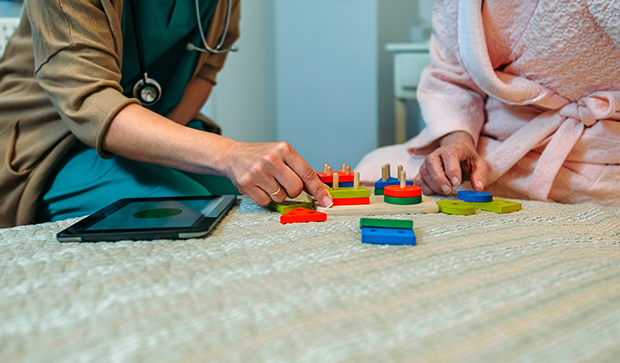
How SAIDO Learning Is Improving Memory Care at Lutheran Hillside Village
By Janet Muhm, Lutheran Senior Services
The Memory Care neighborhood at Lutheran Hillside Village (LHV) truly is a neighborhood. Its main gathering space is flanked by a general store, a dress-up station, and a staged office environment. Dining and sitting areas are neatly defined by attractive oak railings, delineating the spaces where residents come together during the day. It’s a comfortable place, just like a neighborhood should be.
Last summer this Memory Care neighborhood welcomed the much-anticipated launch of SAIDO® Learning. SAIDO, a daily program for people with memory issues, focuses on the prefrontal cortex of the brain where all forms of dementia manifest themselves. When the prefrontal cortex is stimulated by SAIDO therapy, motivation and concentration are improved, slowing the progression of symptoms of Alzheimer’s disease and other dementias.
According to Sanicia Dudley, Social Services Coordinator at LHV, SAIDO is a game changer. “Residents engage more now,” she says. “Before, they often stayed in their rooms instead of participating in activities. Now they spend much more time talking to one another.”
Dudley went through SAIDO training in Ohio, alongside several of her colleagues from Lutheran Hillside Village. As lead “supporters,” this core group has trained several staff and community volunteers, including Independent Living residents of LHV.
The volunteer effort for SAIDO is robust — and appreciated! SAIDO takes time — between 30 to 45 minutes a day, five days a week — for each participating resident. Volunteers go through a full day of training, complete with mock sessions and observation of SAIDO supporters, before they are able to lead learning sessions on their own. Once trained, new supporters work with two learners at a time in a dedicated SAIDO room. This is deemed the optimal arrangement by the program’s developers, because learners tend to encourage one another.
SAIDO Learning focuses on simple math and reading exercises. Pre-tests determine the starting place for learners, making sure that the material is easy for them to grasp. Every six months, learners are re-tested on the three Rs: reading, writing, and ‘rithmetic. These measurements are not the only gauge of success, according to Dudley. “SAIDO is really about quality of life,” she says.
SAIDO’s developers would agree that this is exactly the point of the therapy. The object is not to teach, but to engage learners, to give them confidence. That’s what residents of LHV Memory Care and their families experience once the program has begun. “Residents talk to each other at meal times now,” Dudley says. “That’s a big change from where we were a year ago.”
Dudley talks of a woman who was in hospice last year before the launch of SAIDO. Less than two months after becoming a SAIDO learner, the woman came off hospice and started to engage with those around her. One day, she picked up her cell phone and called her daughter to chat, something she had not done before.
Thanks to SAIDO, LHV’s Memory Care neighborhood is now teeming with life as residents engage with one another in the morning. Later in the day, they will pair up two-by-two for SAIDO Learning. In the evening, when they join their friends for dinner, there will be plenty for them to talk about.
Lutheran Hillside Village is part of the Lutheran Senior Services family of Life Plan Communities, offering a full continuum of care for older adults. Please call 309-692-4600 to schedule a private tour of Lutheran Hillside Village and to learn more about SAIDO Learning.
